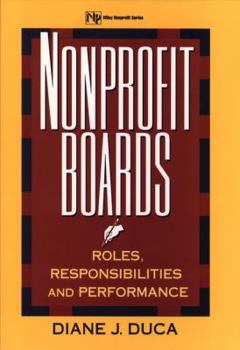Nonprofit Boards: Roles, Responsibilities, and Performance
Select Format
Select Condition 
Book Overview
Any nonprofit that wants to survive beyond the nineties had betterbe governed by an effective, flexible board of directors. But whatrole should a nonprofit board play in fulfilling the organization'smission? How should the board carry out its responsibility to seethat funds and other resources are used in the most efficientpossible manner? How can the board perform its duties withoutalienating staff members? What pitfalls can divert a nonprofitboard from addressing critical board functions? Nonprofit Boards: Roles, Responsibilities, and Performance answersthese questions and many more. This practical guide is dedicated tohelping nonprofit board members, chairpersons, and executivedirectors develop and manage effective boards, empowered to respondto the special needs of their organizations. Diane J. Duca offersdifferent ways to approach organizing and utilizing a board bypresenting different board models. Using case studies andillustrations from real-life situations, she explores every aspectof board management, clarifies the roles of board members andexecutives, and discusses the board's legal and ethicalobligations. In her discussion of core responsibilities--strategic planning, policy setting, fiscal oversight, and fund-raising--Ms. Ducafocuses on creating a spirit of cooperation between board andstaff. Nonprofit boards that successfully fulfill their obligationsand perform responsibly inspire staff members and set an examplefor everyone in the organization. Regardless of your organization's managerial style or the structureof your board--passive or active, entrepreneurial or averse torisk--this invaluable guide will help board members and staff todevelop mission-based policies, increase support, and improvecommunications between board and staff. Nonprofit board members whounderstand and accept their roles as trustees offer a vital servicenot only to their organization but also to society. NonprofitBoards is designed to help them carry out this importantduty. "In my opinion, what was desperately needed from us 'volunteers'were resources, advocacy in the community, and hands-on help for ashoestring operation; instead, we acted like a judiciary body ofadvisors and critics."--Letter from a Former Board Member of aNonprofit Organization Too often, a nonprofit organization's efforts to fulfill itsmission or use its resources efficiently are frustrated by anineffectual, poorly defined, or adversarial relationship betweenthe board and staff. Nonprofit Boards: Roles, Responsibilities, andPerformance will help executives and board members avoid theseconflicts with invaluable guidance and strategies for effectiveboard management. Using case studies and real-life examples, it
* Clarifies the roles and functions of board members and executives
* Details board duties, including strategic planning and fiscaloversight
* Describes different organizational models for nonprofit boardsand discusses their advantages and disadvantages
* Explains how structural diversity within the board can maximizeits effectiveness and flexibility
* Discusses legal and ethical obligations and how the board canensure that the nonprofit fulfills its mission
* Examines cooperative board-staff relations and how a board can bethe catalyst for organizational change
* Includes numerous helpful charts and tables as well as in-depthappendices
* Presents contemporary issues facing nonprofits and their boards, including government relations, image-building, professionalism, and diversity
* Clarifies the roles and functions of board members and executives
* Details board duties, including strategic planning and fiscaloversight
* Describes different organizational models for nonprofit boardsand discusses their advantages and disadvantages
* Explains how structural diversity within the board can maximizeits effectiveness and flexibility
* Discusses legal and ethical obligations and how the board canensure that the nonprofit fulfills its mission
* Examines cooperative board-staff relations and how a board can bethe catalyst for organizational change
* Includes numerous helpful charts and tables as well as in-depthappendices
* Presents contemporary issues facing nonprofits and their boards, including government relations, image-building, professionalism, and diversity
Format:Hardcover
Language:English
ISBN:0471130206
ISBN13:9780471130208
Release Date:October 1996
Publisher:Wiley
Length:208 Pages
Weight:1.25 lbs.
Dimensions:0.9" x 6.2" x 9.2"
Customer Reviews
1 rating
Right on target . . . .
Published by Thriftbooks.com User , 27 years ago
I cannot imagine any development officer, who must expend enormous time, energy and resources recruiting, nurturing, and equipping board members, not wanting perhaps the best-written book on the subject now in print. Nonprofit Boards not only discusses traditional board models -- such as the "tripartite" system of board of directors, executive, and staff -- but suggests alternative models. In so doing, it gets us thinking: Is it okay to reconsider how we do things? Are there other approaches that would make us a more effective organization? How can board members be more effective in fund raising? Diane Duca, executive director of the Edmonds Alliance for Economic Development, writes from more than 20 years experience in the nonprofit sector. She has written is a practical guide to helping nonprofit board members, chairpersons, and executive directors develop and manage effective boards. Her ample use of studies and illustrations, drawn from real-life examples, makes this a practical, usable resource. Importantly, the author cites a 1994 survey of the National Center for Nonprofit Boards which reported that executives most often cited their boards' "lack of fund-raising capability and lack of commitment and involvement" as a major weakness. She points out that less than five per cent of the respondents cited fund-raising as a board strength. Duca hits this vital issue head on. Those of us in fund development will find her discussion right on target.






